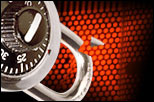Cheaper quantum security coming soon

Researchers from the US National Institute of Standards and Technology (NIST) claim to have discovered a technique that will lower the costs of quantum cryptography.
One of the major costs in quantum cryptography is for photon measurement detectors, which can cost between US$5000 and US$20,000, according to NIST. Researchers from the organisation claim they can halve, and even quarter, the number of photon detectors needed.

In quantum cryptography, polarisation of light can be used to carry encoded information, which can then be decoded depending on the direction of the electrical field, said NIST. The polarisation of these particles can be horizontal, vertical or slanted, with systems using two different polarisations to indicate 1s and 0s.
The most common polarisation-based protocol, BB84, at present requires four single-photon detectors — two to measure photons with horizontal and vertical polarisation, which could indicate 0 and 1 respectively, and two to measure diagonal polarisation, which could indicate 0 or 1, depending on whether the particle is at a plus or minus 45° angle.
The NIST researchers claim in a research paper that they have designed a method that twists slant-polarised light so it's vertical, enabling two detectors to be used for all photons instead of four. It also delays the slant-polarised light so it will never arrive at the same time as vertically polarised light, with post-processing working out from the time of arrival which photons were originally slanted. The NIST blog claimed that, since the paper was written, the researchers have further refined the method to use only one detector for the BB84 protocol.
Moreover, the researchers claim to have made the practical application of quantum cryptography more secure. In theory, any eavesdropping disturbs photons' values, making it detectable. However, in practice, photon detectors have a short period of 'dead time' after recording each photon, theoretically making the information stream less random. NIST claims its method, outlined in the paper, avoids this issue by delaying photons so they fall into predictable arrival times that avoid dead time issues.
The research paper, entitled Experimental demonstration of a detection-time-bin-shift polarization encoding quantum key distribution system, was published in IEEE Communications Letters Volume 12, No 6, June 2008.